
Cubase Patch Scripts Downloads
To easily select MatrixBrute patches from the Track Inspector in Cubase, you can use the attached patch scripts. Open the attached ZIP archive and copy the 'Arturia' folder into this folder (varies slightly with the Cubase install drive and version): C: Users AppData Roaming Steinberg Cubase 6_64 Scripts Patchnames inactive Alternatively you can use the Start Menu to find the folder by selecting the following item: Start Menu -> Steinberg Cubase XYZ -> Cubase Application Data Folder Then browse to scripts Patchnames inactive and copy the folder as detailed above. You can now install the patch script as follows: - open the MIDI Device Manager - click 'Install Device' and select MatrixBrute or MatrixBrute factory (the first uses the row/column names, the second uses the factory patch names) - select 'MatrixBrute' (or the MIDI port it is connected to) in the 'output' menu. To use the patch script, select 'MatrixBrute' or 'MatrixBrute Factory' in the Track Inspector's Output Routing menu (select the entry in the upper part of the menu for the MIDI Device). You should now be able to browse the patches in the Program menu in the Track Inspector.
The attached patch script files can be edited to show your own patch names if you wish. You can have as many patch name files as you want, just use different file names and different names for the [device name] and [script name] fields.
Cubase Instrument Definitions - How To Like Sonar, Cubase uses instrument definitions, called 'patchnames' for use with your hardware synth. They are standard TXT files and are found in the C: Users yourname AppData Roaming Steinberg Cubase Scripts patchnames folder. Any files you create must go in the Inactive folder to work. C: Program Folders Steinberg Cubase Scripts patchnames seems to be a dummy folder as nothing I put there shows up in Cubase. You can write your own files or here's a that can convert Sonar.ins files to Cubase formatted.txt files. Tho it may not work for some hardware it worked for me. From there just follow the instructions to set them up in Cubase.
My synth has 10 banks of 10 voices each arranged in random order. This utility rearranges them by instrument. If you'd rather have the patchnames in the same order as they are in your synth you'll have to do some cutting and pasting after the file is created. Husker Just finished the process of writing definition files for my hardware (FA-08, Moog Slim, Integra-7 and Nord A1).
This is the download area for Cubase related files. Expression Maps, Patch Name Scripts, VST Presets, and Device Panels. These scripts are provided by the community. Please feel free to upload any of your scripts. Expression Maps for: EWQL Products, VSL, Chris Hein, Steinberg, and more.

Time consuming, but fairly easy. I've actually found the Cubase support of external hardware is more robust than Sonar's. Halfway through mine completed a Proteus FX, Akai SG01p and an Evolution EVS-1, Still need to do a Kawai K1-II, Casio VZ-8m, Alesis D4 and POD. Foto porezannie veni. All old, and not used as much as they were but personally I still enjoy working with MIDI Hardware. Working on the SG01p I notice the ability to group in levels which is neat. Reading the documentation it looks like you can store sounds on different ways so I could organise by Bank AND Sound Type, I'm going to try that on the FX later.
Based on what I have seen it makes sense to create the Patch Names by Bank first. I do wish the documentation was better on this. The setup process is about as hard/easy as Sonar's but if I can create different views this seems to add a level of flexibility that Sonar does no have.
The.txt files with patch names do offer some flexibility for organizing patches, but they don't represent the full flexibility of Cubase's patch & bank operations. For example, Cubase can configure very non-standard bank select commands, even sysex, through the device GUI. It's very laborious, as far as I can tell, because it needs to be manually configured for each patch.
It is possible to export, edit, and then import an XML file that represents these commands, but still laborious and time consuming. The.txt files can only encapsulate standard MIDI bank change data. Cubase also provides a means to design custom panels with faders knobs and switches.
But I have not figured out yet how to get a new.txt file of patches into the device without losing the panels. Anydmusic Halfway through mine completed a Proteus FX, Akai SG01p and an Evolution EVS-1, Still need to do a Kawai K1-II, Casio VZ-8m, Alesis D4 and POD. All old, and not used as much as they were but personally I still enjoy working with MIDI Hardware. Working on the SG01p I notice the ability to group in levels which is neat. Reading the documentation it looks like you can store sounds on different ways so I could organise by Bank AND Sound Type, I'm going to try that on the FX later. Based on what I have seen it makes sense to create the Patch Names by Bank first.